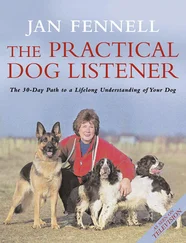The secrets that make gooddog owners great
Harper
An Imprint of HarperCollins Publishers Ltd
1 London Bridge Street
London SE1 9GF
www.harpercollins.co.uk
First published in Great Britain by HarperCollins Entertainment 2004
Copyright © Jan Fennell and Fantasma Partnership 2004
The Author asserts the moral right to be identified as the author of this work
All rights reserved under International and Pan-American Copyright Conventions. By payment of the required fees, you have been granted the nonexclusive, non-transferable right to access and read the text of this e-book on screen. No part of this text may be reproduced, transmitted, downloaded, decompiled, reverse engineered, or stored in or introduced into any information storage retrieval system, in any form or by any means, whether electronic or mechanical, now known or hereinafter invented, without the express written permission of HarperCollins e-books.
HarperCollins Publishers has made every reasonable effort to ensure that any picture content and written content in this ebook has been included or removed in accordance with the contractual and technological constraints in operation at the time of publication
Source ISBN 9780007153725
Ebook Edition © APRIL 2019 ISBN: 9780008363437
Version: 2019-05-13
This ebook contains the following accessibility features which, if supported by your device, can be accessed via your ereader/accessibility settings:
Change of font size and line height
Change of background and font colours
Change of font
Change justification
Text to speech
Page numbers taken from the following print edition: ISBN 9780007153725
For my grandchildren
Ceri-Ann, Bethan and Ben
Cover
Title Page
Copyright
Note to Readers
Dedication
Preface by Monty Roberts
Introduction
‘How Would You Feel?’
Why great owners put themselves in their dog’s place
The Ties That Bind
Why great owners understand man’s special relationship with dogs
‘What’s in it for Me?’
Why great owners work with, not against, their dogs
Our Mutual Friends
Why respect is the key to a great relationship with dogs
Feeling the Force
The importance of drawing on the lessons of others
Living in the Real World
Why great owners know their limits
Role Models
Why great owners lead by example
Second Among Equals
Why great owners always put their dogs first
Flexible Friends
Why great owners keep an open mind
When the Going Gets Tough
Why it pays to show courage under fire
The Great Healer
Why patience really is a virtue
A Dog is for Life
Why great owners understand the meaning of responsibility
99% Preparation
Why great owners think ahead
The Buck Stops Here
Why great owners always shoulder the blame
Happy Families
Why great owners are fun owners
Cometh the Hour
Why great owners rise to the occasion
The Best Dog Comes Home with Us
The importance of owning dogs for the right reasons
Better Happy than Rich
Why great owners understand the real value of dogs
Give a Dog a Good Name
Why great owners don’t pigeonhole their dogs
The Glass Half Full
Why great owners are positive owners
Sense and Sensibility
Why great owners never underestimate their dogs’ instincts
Separate Worlds
Why great owners accept that dogs are different
Letting Go
The importance of knowing when to say goodbye
In Sickness and in Health
When their dogs grow weak, great owners grow strong
Through Thick and Thin
How great owners show strength for their dog’s sake
Reaping the Rewards
Why you only get out what you put in
Breathing Space
The benefits of letting a dog be itself
A Dog’s Best Friend
Why great owners just want to give their dogs the best
Acknowledgements
About the Author
About the Publisher
I can’t remember a time in my life when there wasn’t a dog around and somebody trying to train him to do something. For 65 years or so, I have seen professional dog trainers work, watched amateur dog trainers work and observed as Western rancher-type people as they dealt with their canine assistants. I have seen dogs treated with profound brutality and have witnessed partnerships between dog and human that were as close as one could imagine.
In the early 1950’s, I became acquainted with a man who produced contract dog acts as a part of professional rodeos that were conducted throughout the United States. His name was Jay Sisler and he usually had a gang of border collies with one or two retired racing greyhounds thrown in. I recall that he had a few Australian Shepherds and sometimes an Aussie crossed with a border collie.
Jay Sisler loved his dogs and, probably more importantly, his dogs loved him. I recall times when he would work with a half a dozen dogs or so in one session. I would watch as each dog sat with eyes sparkling and feet prancing in place begging for the opportunity to be the next actor on his stage. Jay specialized in offbeat acts where dogs did things that people just didn’t expect to see.
I remember one night in 1955 when Mr. Sisler turned up at a popular old pub-style restaurant near my university. The proprietor knew about Jay and so allowed him to bring two dogs into the saloon portion of the building. I sat and watched as this man sipped a drink at the bar and then would simply say things in a normal tone of voice that he wanted the dogs to do, and, boy, did they do it!
Watching in utter amazement, I saw these dogs interact with one another and with patrons of the establishment. ‘Blue, go to sleep.’ he would say, and Blue would flatten himself in the middle of the saloon. ‘Freddy, take my jacket and cover Blue up. It’s going to get cold.’ And Freddy would do just that. ‘Now, Freddy, find me a pretty girl. Lead her over to have a drink with me.’ And this dog would circle the room and for all the world it seemed to me that he would pick the most attractive female, gently take her hand in his mouth and lead her to Jay’s side.
They walked tight ropes, sat up on one another’s shoulders, the same as trapeze artists would do. They danced and sang, rode horses, and one would even lead a donkey wherever Jay asked him to go. Sisler loved to create a situation where the Sheppard types would form obstacles over which the greyhound would jump, and those greyhounds could jump the moon. People were consistently left mesmerized by the awesome feats that Jay’s dogs could perform.
For me, it was far more how they did it than what they did. I never saw him strike a dog and I never even heard him raise his voice to one. I don’t know how he did his basic training but looking back on it with two doctorates in behavioural sciences I know how to assess that these dogs did it because they wanted to and because they loved to work with and for this man.
When my book The Dog Listener was first published, I had no idea it would connect with such a wide audience. It is a source of constant pride to me that so many people have turned to the compassionate communication method advocated in its pages. By rejecting the aggressive and damaging ideas of the past, they have displayed the open-mindedness and, I like to think, intelligence that instantly separates the good owner from the bad one. They have made an important first step.
Читать дальше












